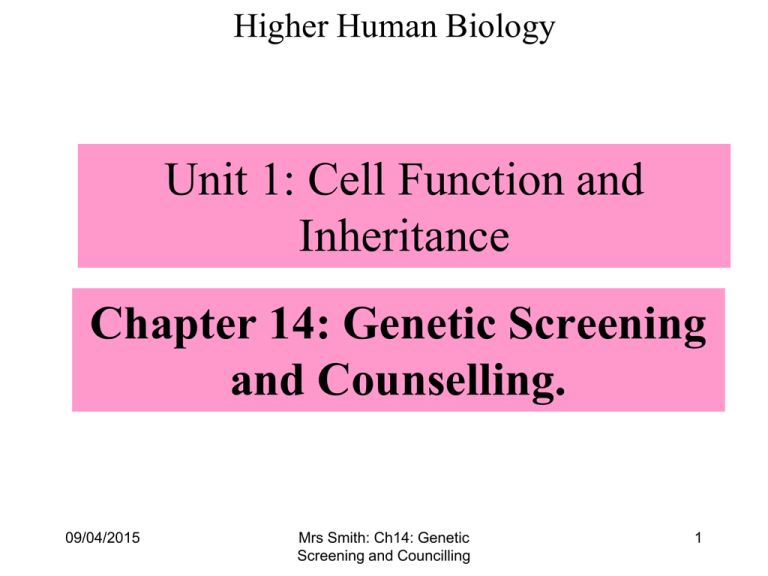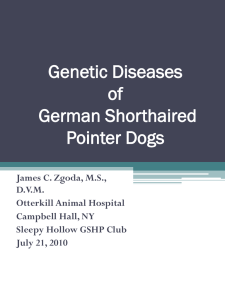
Higher Human Biology
Unit 1: Cell Function and
Inheritance
Chapter 14: Genetic Screening
and Counselling.
09/04/2015
Mrs Smith: Ch14: Genetic
Screening and Councilling
1
Learning Intentions
• By the end of this lesson you should be able to– describe Genetic screening and counselling.
– Explain the use of family histories in determining
genotypes.
• Examples might include albinism, Huntington’s chorea,
cystic fibrosis, phenylketonuria, haemophilia and
muscular dystrophy.
– Explain the use of karyotypes of foetal material where
there is a possibility of genetic disorder.
– Discuss risk evaluation in cases of polygenic inheritance.
– Understand post-natal screening for conditions which have
a genetic basis.
09/04/2015
Mrs Smith: Ch13: Mutations an
Chromosomal Abnormalities
2
You need to know these words
09/04/2015
Mrs Smith: Ch13: Mutations an
Chromosomal Abnormalities
3
Use of Family Histories
• A pattern of human inheritance can be
revealed by collecting information about a
particular characteristic from the members
of a family and then using it to construct a
family tree (pedigree)
09/04/2015
Mrs Smith: Ch14: Genetic Screening
and Councilling
4
Types of pedigree
• There are 3 types of pedigree that you need
to know about
– Autosomal recessive inheritance
– Autosomal dominant inheritance
– Sex-linked recessive trait.
09/04/2015
Mrs Smith: Ch14: Genetic Screening
and Councilling
5
The Geneticist recognises Autosomal
Recessive Inheritance because....
•
•
•
•
•
The trait is rarely expressed
The trait tends to skip generations
The trait is expressed in some cousins
Males and females are equally affected
All sufferers of the trait are homozygous
recessive
• Non-sufferers are homozygous dominant or
heterozygous.
09/04/2015
Mrs Smith: Ch14: Genetic Screening
and Councilling
6
Autosomal recessive inheritance
e.g Cystic Fibrosis
09/04/2015
Mrs Smith: Ch14: Genetic Screening
and Councilling
7
The Geneticist recognises Autosomal
Dominant Inheritance because....
• The trait appears in every generation.
• Each sufferer has an affected parent.
• When a branch of the family does not express the
trait it fails to reappear in future generations of that
branch.
• Males and females are equally affected.
• All non-sufferers are homozygous.
• Sufferers are homozygous dominant or heterozygous.
09/04/2015
Mrs Smith: Ch14: Genetic Screening
and Councilling
8
Autosomal Dominant Inheritance
e.g. Huntington’s Chorea
09/04/2015
Mrs Smith: Ch14: Genetic Screening
and Councilling
9
The Geneticist recognises Sexlinked recessive because.....
•
•
•
•
•
More males are affected than females
None of the sons of an affected male show the trait
Some grandsons of affected males show the trait
All sufferers of the trait are homozygous recessive
Non-sufferers are homozygous dominantor or
heterozygous carrier females
09/04/2015
Mrs Smith: Ch14: Genetic Screening
and Councilling
10
Sex-linked recessive trait
e.g. haemophilia
09/04/2015
Mrs Smith: Ch14: Genetic Screening
and Councilling
11
Sex-linked recessive trait
e.g. haemophilia
09/04/2015
Mrs Smith: Ch14: Genetic Screening
and Councilling
12
FYI - Genetic code
• In 1966, the Genetic code was discovered
• Human Genome Project to determine
nucleotide sequence of human DNA began in
1990 and was completed in 2003.
• Scientists are now able to predict
characteristics by studying DNA. This leads to
genetic engineering, genetic counseling.
09/04/2015
Mrs Smith: Ch14: Genetic Screening
and Councilling
13
Genetic code
An
international
team of
scientists
began the
project to map
the human
genome.
09/04/2015
Mrs Smith: Ch14: Genetic Screening
and Councilling
14
Genetic Code
09/04/2015
Mrs Smith: Ch14: Genetic Screening
and Councilling
15
Genetic Code
In 1990, gene therapy
was used on patients
for the first time
09/04/2015
Mrs Smith: Ch14: Genetic Screening
and Councilling
16
Assessing the risk!
• Once the genetic councillor has constructed
the family tree(s) and established as many
genotypes as possible, he/she is in a position
to assess the risk and state the possibilities.
09/04/2015
Mrs Smith: Ch14: Genetic Screening
and Councilling
17
Assessing the risk – Autosomal
recessive. e.g. cystic fibrosis
• If a couple were considering having a family, however the
female knows cystic fibrosis runs in her family but not in her
partners.
• They could approach a genetic councillor.
• By analysing her family tree the councillor could work out
there was a 2:3 chance that the female is a carrier.
• The councillor would already know the frequency in the
British population as 1:25 for carrying the heterozygous allele
for CF – this is the risk of her partner being a carrier.
• The councillor would then conclude the risk of having a child
with CF as low.
Mrs Smith: Ch14: Genetic Screening
18
and Councilling
Assessing the risk – Autosomal
Dominant. e.g. Huntington’s chorea
• Consider a brother and sister, unlike their siblings they are
too young to know if they have received the harmful allele
from an affected parent.
• They could approach a genetic councillor.
• The councillor would already know the frequency in the
British population, and there is a 1:2 chance that each is
heterozygous allele for HC
• By analysing her family tree the councillor would then
conclude the risk of having of each sibling suffering this
debilitating disease as high.
Mrs Smith: Ch14: Genetic Screening
and Councilling
19
Assessing the risk – sex-linked. e.g.
Haemophilia
• If a couple were considering having a family, however the female
knows Haemophilia runs in her family but not in her partners.
She is anxious to know if she could pass the trait onto her sons.
• They could approach a genetic councillor.
• By analysing her family tree the councillor would note that the
woman's brother and sisters son her nephew have developed this
sex linked trait.
• This shows her sister and mother are carriers.
• The councillor would then conclude a she has a 1:2 risk of being
carrier and a 1:4 risk that each son will be a haemophiliac.
Mrs Smith: Ch14: Genetic Screening
and Councilling
20
Advantage and disadvantagr of
Genetic counselling
• The aim of genetic counselling is to help
people to make well informed decisions for
themselves based on information available.
• Advantage: Analysis of a family tree
allows the expert to chart he pattern of the
disorder.
• Disadvantage: It is of limited value in that
it can only offer an assessment of risk.
09/04/2015
Mrs Smith: Ch14: Genetic Screening
and Councilling
21
Pre-natal Screening
• If after assessing the risk of having baby
with a genetic disorder. AND IF the couple
decide to go ahead and have a baby prenatal screening can be employed.
• Two methods of pre-natal screening depend
on foetal material being obtained to allow
karyotypes to be examined
– Amniocentesis
– Chorionic villus sampling (CVS)
09/04/2015
Mrs Smith: Ch14: Genetic Screening
and Councilling
22
Amniocentesis
09/04/2015
• Amniocentesis is carried
out in the 18th week of
pregnancy.
• It involves the withdrawal
of a little amniotic fluid
containing foetal cells.
• These cells can be
analysed and a full
karotype made.
• It slightly increases risk
of miscarriage
23
Chorionic Villus
Sampling
• A small tube is inserted into
the womans reproductive
tract, placental cells are
removed, these cells are
used for karyotyping
• ADV: CVS can be carried
out at 8 weeks of pregnancy
• DISADV: Causes a higher
risk of miscarriage then
amniocentesis
09/04/2015
24
Post-natal Screening
• At present none of the inherited disorders can be
successfully treated except for PKU
• Phenylketonuria results from an inborn error of
metabolism for 1:10000 b irths in Britain.
• If not detected soon after birth the baby suffers
from mental retardation
• All British babies are routinely tested for excess
phenylalanine after birth by means of a blood test
09/04/2015
Mrs Smith: Ch14: Genetic Screening
and Councilling
25
Testing for PKU: Guthrie's test
09/04/2015
Mrs Smith: Ch14: Genetic Screening
and Councilling
26
Task: TYK -Torrance pg106 Qu’s 1-3
09/04/2015
Mrs Smith: Ch13: Mutations an
Chromosomal Abnormalities
27
Task: AYK -Torrance pg 106-7 Qu’s 1-4
09/04/2015
Mrs Smith: Ch13: Mutations an
Chromosomal Abnormalities
28
Essay Question Guide to H-Grade
essays pg 64
By means o examples you have studied discuss
genetic conditions of medical importance with
reference to the following:
– Family History
– Use of Karyotypes
– Post-natal Screening.
(15)
09/04/2015
Mrs Smith
29









